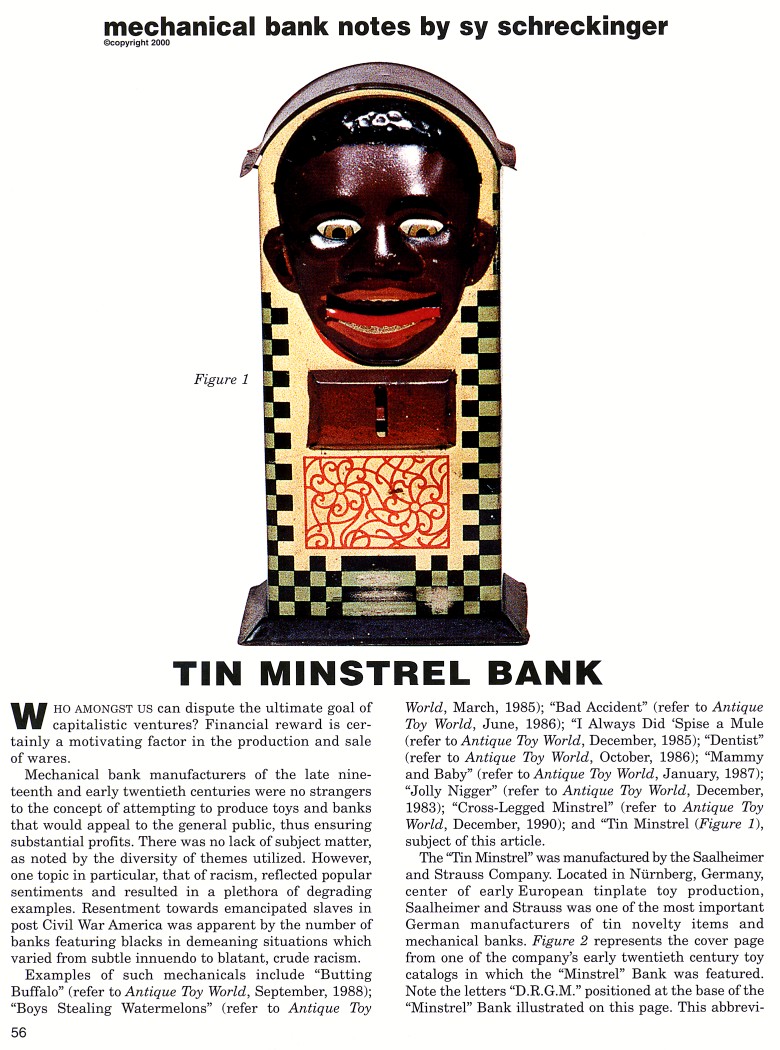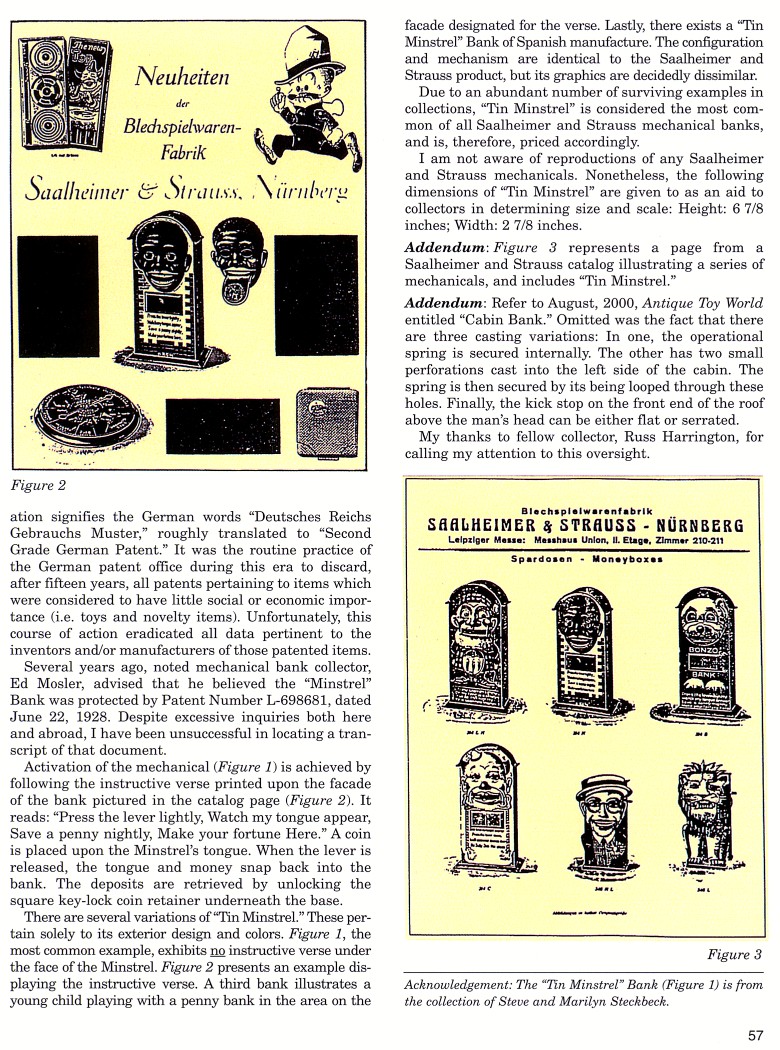|
Tin Minstrel Bank
by Sy Schreckinger – ANTIQUE TOY WORLD Magazine – October, 2000
Who amongst us can dispute the ultimate goal of
capitalistic ventures? Financial reward is certainly a motivating factor
in the production and sale of wares.
Mechanical bank manufacturers of the late nineteenth and early
twentieth centuries were no strangers to the concept of attempting to
produce toys and banks that would appeal to the general public, thus
ensuring substantial profits. There was no lack of subject matter, as
noted by the diversity of themes utilized. However, one topic in
particular, that of racism, reflected popular sentiments and resulted in a
plethora of degrading examples. Resentment towards emancipated slaves in
post Civil War America was apparent by the number of banks featuring
blacks in demeaning situations which varied from subtle innuendo to
blatant, crude racism.
Examples of such mechanicals include "Butting
Buffalo" (refer to Antique Toy World,
September, 1988); "Boys Stealing
Watermelons" (refer to Antique Toy World,
March, 1985); "Bad Accident"
(refer to Antique Toy World,
June, 1986); "I Always Did 'Spise a Mule (refer to Antique Toy
World, December, 1985); "Dentist" (refer to Antique Toy World,
October,
1986); "Mammy and Baby" (refer to Antique Toy World,
January, 1987);
"Jolly Nigger" (refer to Antique Toy World,
December, 1983); "Cross-Legged
Minstrel" (refer to Antique Toy World,
December, 1990); and "Tin Minstrel
(Figure 1), subject of this article.
The "Tin Minstrel" was manufactured by the Saalheimer and Strauss
Company. Located in Nurnberg, Germany, center of early European tinplate
toy production, Saalheimer and Strauss was one of the most important
German manufacturers of tin novelty items and mechanical banks. Figure 2
represents the cover page from one of the company's early twentieth
century toy catalogs in which the "Minstrel" Bank was featured. Note the
letters "D.R.G.M." positioned at the base of the "Minstrel" Bank
illustrated on this page. This abbreviation signifies the German words "Deutsches
Reichs Gebrauchs Muster," roughly translated to "Second Grade German
Patent." It was the routine practice of the German patent office during
this era to discard, after fifteen years, all patents pertaining to items
which were considered to have little social or economic importance (i.e.
toys and novelty items). Unfortunately, this course of action eradicated
all data pertinent to the inventors and/or manufacturers of those patented
items.
Several years ago, noted mechanical bank collector, Ed Mosler,
advised that he believed the "Minstrel" Bank was protected by Patent
Number L-698681, dated June 22, 1928. Despite excessive inquiries both
here and abroad, I have been unsuccessful in locating a transcript of that
document.
Activation of the mechanical (Figure 1) is achieved by following the
instructive verse printed upon the facade of the bank pictured in the
catalog page (Figure 2). It reads: "Press the lever lightly, Watch my
tongue appear, Save a penny nightly, Make your fortune Here." A coin is
placed upon the Minstrel's tongue. When the lever is released, the tongue
and money snap back into the bank. The deposits are retrieved by unlocking
the square key-lock coin retainer underneath the base.
There are several variations of "Tin Minstrel." These pertain solely
to its exterior design and colors. Figure 1, the most common example,
exhibits no instructive verse under the face of the Minstrel. Figure 2
presents an example displaying the instructive verse. A third bank
illustrates a young child playing with a penny bank in the area on the
facade designated for the verse. Lastly, there exists a "Tin Minstrel"
Bank of Spanish manufacture. The configuration and mechanism are identical
to the Saalheimer and Strauss product, but its graphics are decidedly
dissimilar.
Due to an abundant number of surviving examples in collections, "Tin
Minstrel" is considered the most common of all Saalheimer and Strauss
mechanical banks, and is, therefore, priced accordingly.
I am not aware of reproductions of any Saalheimer and Strauss
mechanicals. Nonetheless, the following dimensions of "Tin Minstrel" are
given to as an aid to collectors in determining size and scale: Height:
6-7/8 inches; Width: 2-7/8 inches.
Addendum: Figure 3 represents a page from a Saalheimer and
Strauss catalog illustrating a series of mechanicals, and includes "Tin
Minstrel."
Addendum: Refer to
August, 2000, Antique Toy World entitled
"Cabin Bank." Omitted was the fact that there are three casting
variations: In one, the operational spring is secured internally. The
other has two small perforations cast into the left side of the cabin. The
spring is then secured by its being looped through these holes. Finally,
the kick stop on the front end of the roof above the man's head can be
either flat or serrated.
My thanks to fellow collector, Russ Harrington, for calling my
attention to this oversight.
Acknowledgement: The "Tin Minstrel" Bank (Figure 1) is from the
collection of Steve and Marilyn Steckbeck.
|

